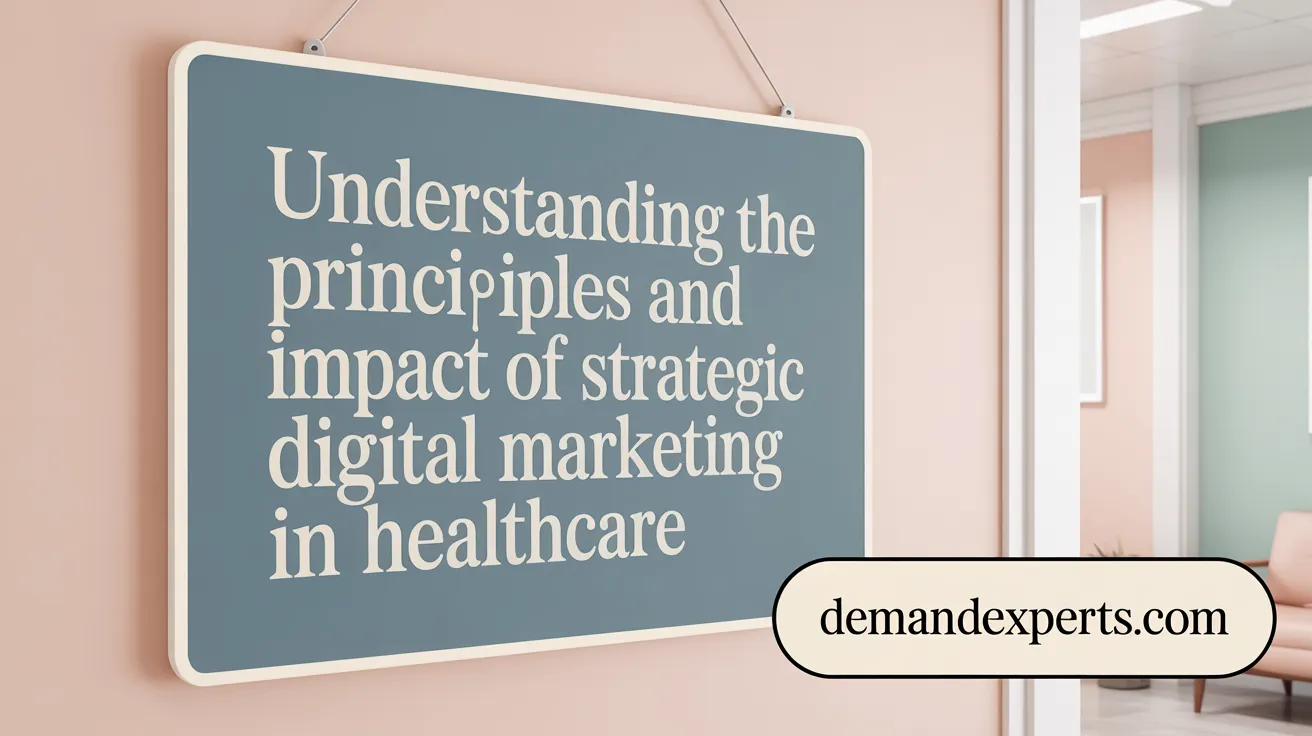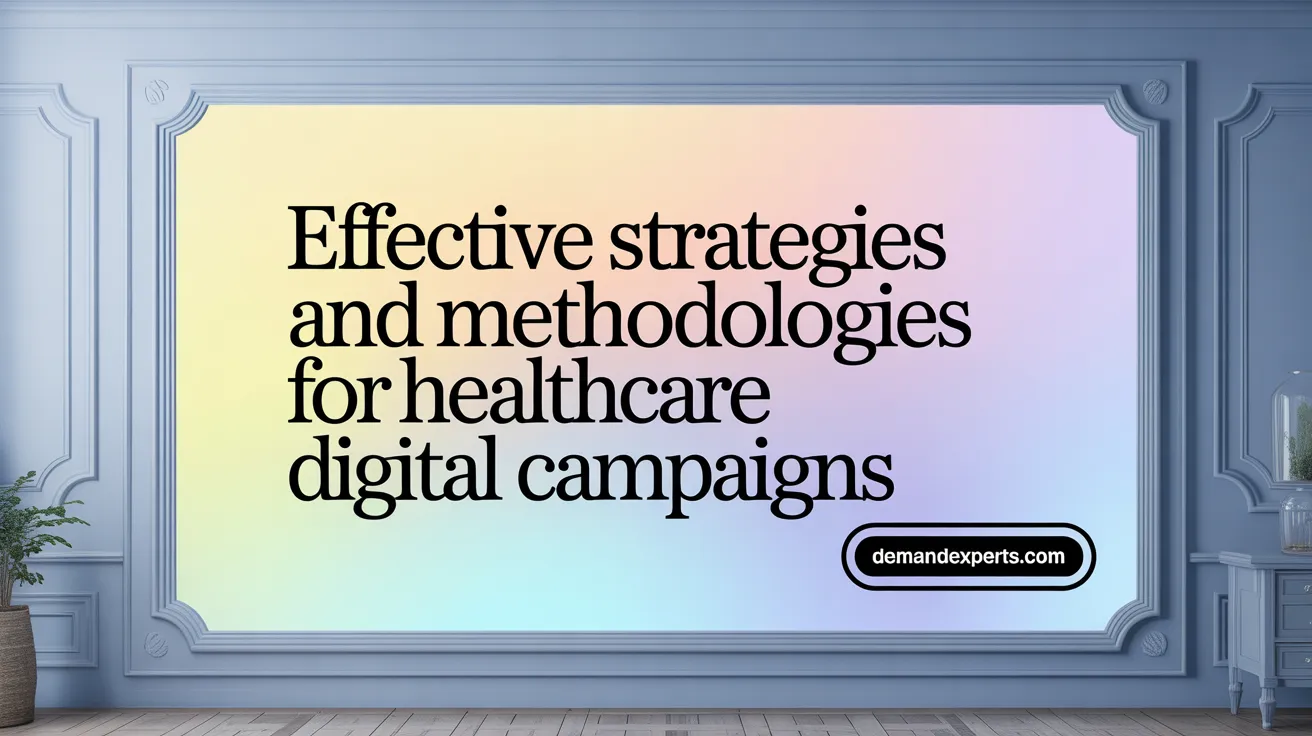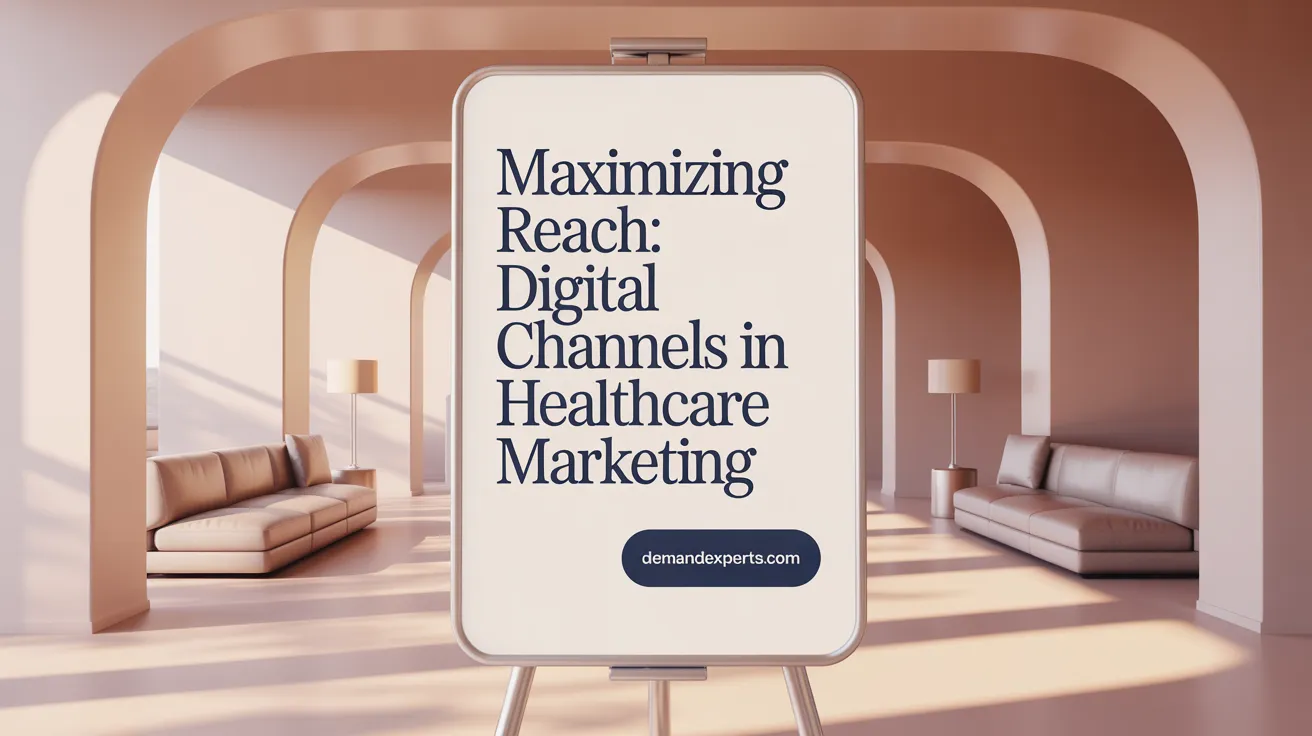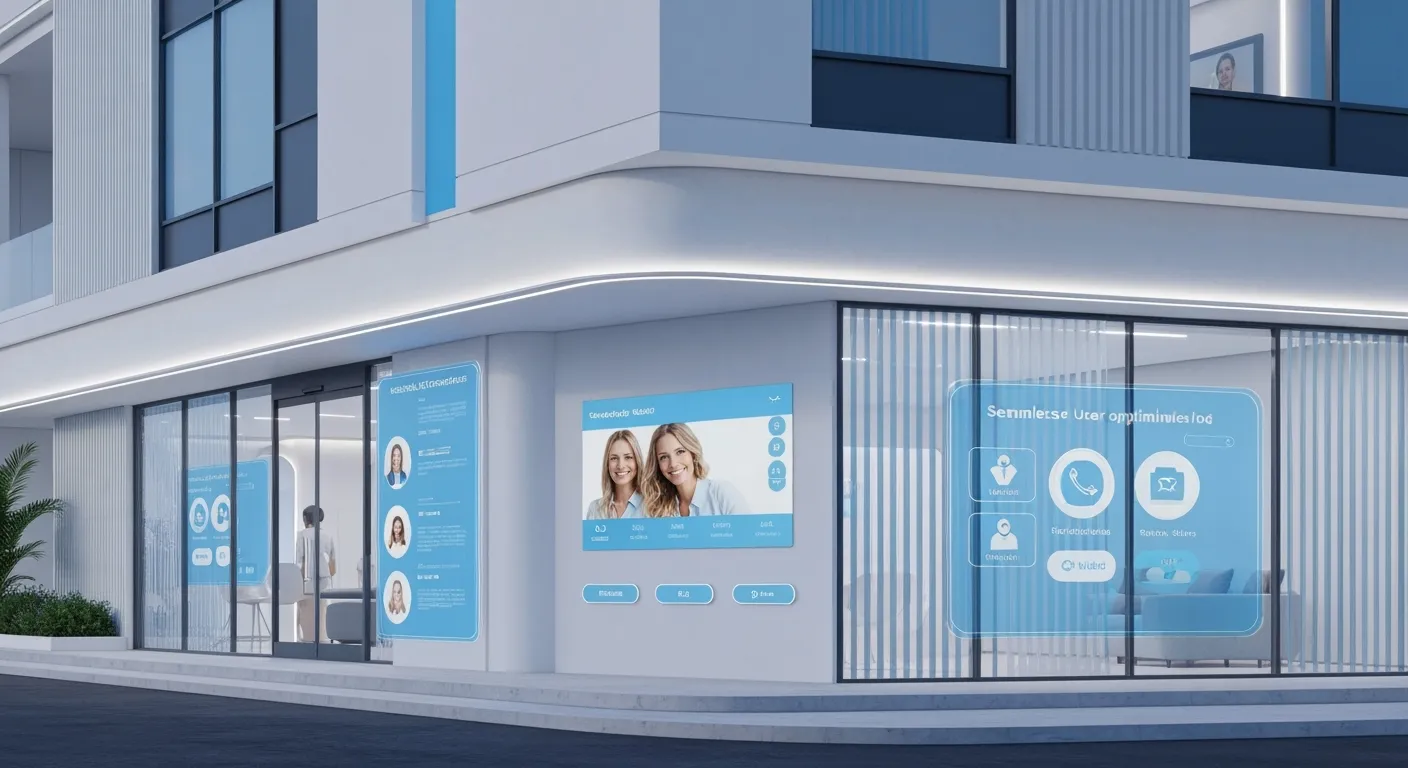Why Strategic Digital Marketing is Vital for Healthcare Growth
In today's rapidly evolving healthcare landscape, strategic digital marketing has become indispensable for healthcare organizations aiming to increase patient acquisition and retention. With over 80% of patients using digital platforms to seek healthcare information, providers must adopt targeted, patient-centric digital strategies that build trust, enhance brand presence, and streamline the patient journey. This article explores foundational principles, best practices, innovative channels, and emerging technologies that empower healthcare providers to engage patients effectively while complying with regulations and ethical standards.
Foundations and Importance of Strategic Digital Marketing in Healthcare

What are the principles and importance of strategic digital marketing in healthcare?
Strategic digital marketing in healthcare is centered on understanding and meeting patient needs through targeted and personalized communication efforts. Its core principles include human-centered design, which emphasizes empathy and relevance in messaging; community involvement, leveraging local partnerships and trust; and responsible data governance, ensuring patient privacy and compliance with regulations like HIPAA.
Utilizing advanced technologies such as AI and predictive analytics helps healthcare providers improve care coordination, personalize patient journeys, and reach underserved populations effectively. By doing so, organizations can enhance patient engagement, satisfaction, and loyalty.
The importance of this approach is multifaceted. Effective digital marketing not only increases patient acquisition and retention but also builds trust through transparency and consistent messaging. It aids in reputation management and educates audiences about health services, fostering informed decision-making.
Employing innovative content strategies—like informative blogs, videos, and social media campaigns—along with responsive websites and online reviews, helps streamline the patient experience from initial search to ongoing care. This strategic focus ensures healthcare marketing remains adaptable, compliant, and community-oriented.
Overall, principles of strategic digital marketing are vital for health organizations striving to improve health outcomes, enhance community trust, and stay competitive in an increasingly digital world, making patient-centricity and transparency fundamental to their success.
Best Practices and Methodologies for Managing Healthcare Digital Marketing Campaigns

What are the best practices and methodologies for managing healthcare digital marketing campaigns effectively?
Managing healthcare digital marketing campaigns requires a strategic, patient-centered approach that focuses on building trust, engaging audiences, and continuously optimizing efforts.
A key practice is understanding both the explicit needs and latent concerns of patients. This involves conducting detailed market research in healthcare and gathering feedback directly from patients through surveys, reviews, and interactive channels. Such insights help tailor messages to resonate on a personal level, fostering long-term relationships in healthcare marketing.
Implementing multi-channel strategies is essential. Healthcare organizations should leverage a mix of social media marketing for healthcare, blogs, email, and mobile platforms to maximize reach and engagement. Since over 80% of patients actively use smartphones, ensuring mobile-friendliness, responsive content, and easy navigation during campaign execution enhances the patient experience and improves interaction rates (mobile healthcare marketing expenditure).
Patient involvement and feedback are vital. Incorporating mechanisms for real-time feedback, such as automated patient feedback collection and review prompts, ensures campaigns stay relevant and trustworthy. This ongoing dialogue builds credibility and encourages loyalty, which in turn attracts new patients through positive word-of-mouth (online reviews and reputation management).
Data analytics play a central role in effective campaign management. Utilizing tools that track performance metrics—such as engagement rates, conversion paths, and patient satisfaction scores—allows for ongoing optimization. Analyzing this data helps identify what works, what needs adjustment, and how to allocate resources efficiently (measuring marketing performance in healthcare).
Focusing on service quality and patient experience is always paramount. Clear, empathetic communication, transparency, and high-quality digital content improve patient perceptions and satisfaction. Strategies like personalizing messages based on demographic and behavioral data further enhance perceived value.
By combining advanced digital tools, market intelligence, and a genuine focus on patient needs, healthcare marketers can develop campaigns that not only attract new patients but also foster meaningful, lasting relationships. This holistic approach ensures continuous improvement, better service delivery, and increased organizational visibility in an increasingly competitive healthcare landscape.
Leveraging Digital Channels: Social Media, SEO, Content Marketing, and Paid Advertising

In today’s digital-first healthcare environment, providers can significantly enhance their outreach and patient engagement through a strategic combination of SEO, social media, content marketing, and paid advertising.
Effective search engine optimization (SEO) is fundamental for improving visibility in local search results. Optimizing websites with relevant keywords, accurate business listings, and local signals like city names and embedded maps ensures that prospective patients find your practice when searching for healthcare services nearby. Local SEO is particularly vital as over 44% of patients research hospitals and clinics on mobile devices, making mobile responsiveness and quick load times critical for ranking higher and providing a seamless user experience.
Social media serves as a powerful tool for engaging current and prospective patients. Platforms like Facebook, Instagram, TikTok, and LinkedIn enable healthcare providers to share educational content, promote health initiatives, and respond directly to patient questions. According to recent data, up to 41% of patients are influenced by social media when choosing healthcare providers. Building trusted online communities through regular, patient-centric content fosters brand loyalty and improves reputation.
Content marketing, including patient testimonials, success stories, and expert blogs, plays a crucial role in establishing authority and trust. Healthcare organizations that feature authentic patient stories and professional health information on their websites and social channels can boost engagement and credibility. Positive reviews collected online and showcased on review platforms also significantly influence new patient decisions.
Paid advertising, such as Google Ads and social media ads, allows precise targeting of specific demographics based on age, location, and health interests. Remarketing campaigns help re-engage users who have previously interacted with your site, increasing conversion chances. Leveraging data-driven insights from advanced analytics and attribution models ensures that campaigns are measurable, optimizing the return on investment (ROI). Additionally, new channels like digital out-of-home and Connected TV (CTV) advertisements expand outreach during critical decision points for patients.
Collaboration across healthcare executive teams, including CMOs, CIOs, and CFOs, supports comprehensive digital strategies that integrate technology, branding, and patient experience initiatives. By continuously monitoring campaign performance and leveraging AI-driven targeting, providers can deliver personalized, compliant, and impactful digital marketing efforts that improve access, trust, and overall patient outcomes.
Data-Driven Marketing Strategies and Analytics for Optimizing Patient Acquisition

How are data-driven marketing strategies and analytics utilized to optimize patient acquisition in healthcare?
Healthcare organizations increasingly rely on advanced data analytics in healthcare marketing and segmentation techniques to boost patient acquisition efforts. By collecting comprehensive data on patient demographics, health risks, social determinants of health (SDOH), and digital engagement behaviors, providers can create highly targeted marketing campaigns. Predictive analytics models analyze this data to identify high-value prospects and forecast demand for specific services.
Segmentation based on social factors like transportation access, education level, and community resources allows for personalized outreach, ensuring messaging resonates with diverse patient groups. Real-time tracking tools monitor campaign performance through KPIs such as cost per acquisition (CPA) and patient lifetime value, enabling dynamic adjustments for maximum efficiency.
Furthermore, integrating data from electronic medical records (EMR), referral patterns, and patient journey workflows helps refine multichannel strategies—such as social media advertising, email campaigns, and community outreach—by targeting the right audience at the right time.
To ensure compliance with privacy laws like HIPAA, healthcare providers employ strict data hygiene practices and use secure, HIPAA-compliant analytics platforms. Customer relationship management (CRM) systems and healthcare-specific analytics tools facilitate segmentation, automate personalized marketing efforts, and measure ROI.
Overall, leveraging big data through predictive analytics enables healthcare organizations to enhance targeting precision, streamline marketing budgets, and increase patient acquisition rates. When executed effectively, these strategies lead to stronger patient relationships, higher engagement, and better health outcomes, ultimately driving organizational growth.
Enhancing Healthcare Branding and Online Presence through Digital Marketing

Digital marketing has become essential for healthcare organizations aiming to strengthen their brand and improve their online visibility. Its primary role is to enable providers to produce consistent, authoritative content that fosters trust among current and prospective patients. Through engaging blogs, social media updates, and patient testimonials, healthcare brands can showcase their expertise and humanize their services, making their identity more relatable and credible.
Moreover, effective online reputation management is crucial. Monitoring reviews, responding professionally to patient feedback, and actively encouraging satisfied patients to share positive experiences help build a trustworthy reputation. This ongoing process influences patient choices and enhances the organization’s standing in search engine results.
The COVID-19 pandemic significantly accelerated the adoption of digital tools. With restrictions on physical marketing avenues, healthcare providers shifted to digital channels, such as telehealth, social media, and targeted advertising. This shift not only maintained patient engagement but also expanded reach beyond traditional boundaries, reinforcing the importance of a robust digital presence.
Differentiating a healthcare brand in a competitive landscape requires strategic, compliant use of digital marketing. By leveraging the latest technologies—such as artificial intelligence, automation, and data analytics—organizations can personalize communication, optimize their content, and adapt swiftly to changing patient needs. These efforts culminate in a sustained competitive advantage, increased patient loyalty, and a distinguished market position.
In essence, digital marketing enhances healthcare branding by creating a consistent narrative, optimizing online reputation, adapting to evolving patient behaviors, and utilizing innovative tools. This integrated approach ensures healthcare providers remain relevant, trusted, and accessible in an increasingly digital healthcare environment.
Patient Journey Mapping, Reputation Management, and Monitoring Strategies
What strategies support patient journey mapping, reputation management, and reputation monitoring in healthcare digital marketing?
Effective healthcare digital marketing relies on a combination of strategies that focus on understanding and enhancing the patient experience from start to finish. Central to this approach is developing detailed patient personas, crafted through comprehensive data collection techniques such as patient surveys, analysis of social media interactions, and direct phone conversations. These personas allow healthcare providers to tailor messaging and services to meet specific patient needs and preferences, creating a more personalized and engaging experience (Healthcare marketing strategies).
Mapping the entire patient journey—from initial awareness and consideration to post-treatment follow-up and advocacy—enables organizations to identify and optimize critical touchpoints. This multichannel approach merges online platforms like social media, websites, and email with offline interactions such as community events and in-office communications (Healthcare digital marketing, Patient Acquisition Guide). Consistent, targeted content at each stage ensures seamless navigation, builds trust, and encourages long-term loyalty (Patient engagement in healthcare, Digital healthcare marketing).
Reputation management plays a vital role in maintaining a positive public image. Monitoring online reviews, patient feedback, and sentiment through tools like Press Ganey, Google Reviews, and sentiment analysis software allows providers to gauge patient perceptions in real time (Managing Online Reviews in Healthcare, Healthcare reputation management). Prompt responses to reviews, especially negative ones, demonstrate a commitment to patient satisfaction and continuous improvement (Reputation Management for Healthcare).
Utilizing call tracking and attribution technologies helps measure the effectiveness of marketing campaigns by analyzing how patients interact with different channels throughout their journey. These insights inform strategic adjustments, improving patient engagement and boosting organizational reputation (Call tracking with Invoca in healthcare marketing, Healthcare marketing performance tracking).
Looking ahead, integrating advanced technologies such as AI-powered analytics can further enhance understanding of patient behavior and preferences. Telehealth services and personalized content driven by data insights can significantly improve the quality of interactions, making healthcare marketing more precise and trust-based (Healthcare AI integration, Data analytics in healthcare marketing).
In summary, a strategic blend of detailed patient personas, multichannel journey optimization, active reputation monitoring, and sophisticated analytics creates a robust foundation for successful healthcare marketing today and into the future (Healthcare marketing evolution, Effective Acquisition Strategies in Healthcare Marketing).
Emerging Trends and Technological Tools Supporting Healthcare Marketing
Current healthcare marketing efforts are increasingly driven by advanced digital healthcare marketing strategies, including the use of artificial intelligence (AI) and specialized tools like Invoca to optimize outreach and patient engagement.
One prominent trend is the enhancement of SEO practices tailored for healthcare. Localized Google Business Profiles, physician profile optimization, and mobile-friendly content ensure organizations appear prominently in local search results, essential as most patients search for providers on smartphones.
AI technologies are transforming how healthcare providers understand and connect with patients. Predictive analytics analyze consumer data, forecast healthcare trends, and personalize marketing messages based on individual health behaviors and social determinants of health (SDOH). Chatbots and virtual assistants offer immediate, personalized responses to patient inquiries, improving service accessibility and satisfaction.
Tools like Invoca facilitate detailed call tracking, attribution, and real-time analytics. They help healthcare marketers identify which campaigns and channels generate quality calls, enabling precise ROI measurement and campaign refinement. Invoca’s HIPAA-compliant platform ensures that patient privacy is maintained while leveraging call data for targeted marketing.
Video marketing and social media communities play vital roles in building trust and authority. Educational videos, patient testimonials, and live Q&As shared through platforms like YouTube, TikTok, and Facebook foster engagement. Developing digital health communities through patient support groups and influencer collaborations extends reach and strengthens patient-provider relationships.
An omnichannel approach combines programmatic advertising, geofencing, self-appointment booking, and secure messaging. HIPAA-compliant remarketing campaigns personalize outreach without compromising data privacy, ensuring that marketing efforts are both effective and lawful.
Overall, integrating these technological tools and trends helps healthcare organizations deliver personalized, accessible, and trustworthy healthcare marketing strategies. This dynamic approach addresses patients’ evolving expectations for digital communication, improves service visibility, and enhances competitive positioning in the healthcare landscape.
The Impact of Digital Marketing on Patient Engagement During the COVID-19 Pandemic
How has digital marketing impacted patient engagement during critical periods like the COVID-19 pandemic?
The COVID-19 pandemic reshaped how healthcare organizations interact with their patients, with digital marketing playing a vital role in maintaining engagement during this challenging time.
Digital platforms became essential for providing accessible, real-time information. Hospitals and clinics used websites, social media, and content marketing to communicate safety measures, vaccine information, and treatment options, ensuring patients stayed informed even when in-person visits were restricted.
The expansion of telehealth and virtual care services was a direct result of digital marketing efforts. By promoting online consultations and remote care options, healthcare providers kept their services available and strengthened patient trust and convenience.
Effective Search Engine Optimization (SEO) and targeted online advertising helped healthcare organizations increase their visibility, ensuring that patients could easily find relevant information and services during an emergency.
Online reviews and reputation management became even more critical, as patients relied heavily on feedback and credible online presence to choose providers during times of uncertainty.
Overall, digital marketing not only sustained patient engagement but also enabled healthcare providers to adapt swiftly—delivering vital health information, building trust, and ensuring continued care amidst unprecedented disruptions.
Influence of Digital Marketing on Patient Acquisition, Retention, and Loyalty
How does digital marketing influence patient acquisition, retention, and loyalty in healthcare?
Digital marketing has become a cornerstone in modern healthcare marketing strategies, fundamentally shaping how providers attract and maintain patient relationships. By leveraging advanced targeting and personalized outreach, healthcare organizations can reach prospective patients with targeted online marketing campaigns, engaging content, and optimized search engine presence. For instance, well-crafted SEO efforts and localized digital campaigns make it easier for potential patients to find relevant services when searching online, significantly boosting patient acquisition.
Beyond initial engagement, digital marketing fosters ongoing communication that nurtures patient loyalty. Through regular email newsletters, social media activity, and digital reminders, healthcare providers can stay connected with patients, enhancing their experience and encouraging prolonged engagement. This consistent contact builds trust, informs patients about new services or health tips, and promotes a sense of community as seen in patient engagement in healthcare marketing.
Additionally, the ability to gather real-time feedback through online reviews, surveys, and social listening tools enables providers to monitor and enhance their reputation. Responding to patient reviews and addressing concerns promptly not only boosts trust but also demonstrates a commitment to quality care, reinforcing loyalty.
In essence, comprehensive digital marketing strategies directly impact revenue growth by attracting new patients and cultivating long-term relationships. These ongoing efforts, rooted in personalized content and real-time engagement, are vital in creating a loyal patient base that returns, advocates, and refers others, ultimately strengthening the healthcare organization’s position in a competitive market (Healthcare marketing strategies, patient retention vs acquisition strategies).
Implementing and Measuring Success in Healthcare Digital Marketing Initiatives
To effectively establish and assess the impact of digital marketing in healthcare efforts in healthcare, providers must start with clear, specific objectives that align with overall organizational goals. This can include increasing online patient inquiries, boosting appointment bookings, or improving patient satisfaction scores.
A multi-channel marketing approach is essential, employing strategies such as search engine optimization (SEO), pay-per-click (PPC) advertising, social media engagement, and valuable content marketing. Selecting appropriate key performance indicators (KPIs) — like website traffic, conversion rates, patient engagement metrics, and online reviews — allows healthcare organizations to track progress accurately.
Utilizing analytics tools such as Google Analytics, call tracking platforms like Invoca, and patient feedback systems is critical. These tools provide real-time data on campaign performance, which facilitates ongoing adjustment of marketing tactics. For instance, monitoring which channels generate the most inquiries or conversions helps optimize budget allocation and messaging.
Compliance with legal and ethical standards, including HIPAA and FDA regulations, must be maintained at all times. This involves careful handling of patient data, securing consent for targeted marketing, and ensuring communications do not contain misleading or prohibited claims. Ethical standards help build trust and uphold the reputation of healthcare organizations.
Continuous analysis of marketing performance and patient feedback enables ongoing refinement. By interpreting these insights, providers can adjust content, improve user experience, and enhance engagement strategies.
Success in healthcare digital marketing is not solely defined by quantitative KPIs but also by qualitative factors such as increased trust, better patient experiences, and stronger community relationships. Ultimately, this integrated approach fosters sustainable growth and enhances the overall quality of healthcare delivery.
Ethical Considerations and Industry Standards in Healthcare Digital Marketing
What ethical considerations and industry standards are important in healthcare digital marketing?
In healthcare digital marketing, ethical considerations are paramount due to the sensitive nature of health information and the vulnerable position of patients. Protecting patient privacy and data security is the foundation, with adherence to regulations such as the Health Insurance Portability and Accountability Act (HIPAA compliance in marketing) in the U.S. and the General Data Protection Regulation (GDPR) in Europe. Beyond legal compliance, organizations should adopt transparent policies that inform patients about data collection, usage, and their rights, ensuring informed consent processes are clear and voluntary.
Accuracy and honesty in content are critical. All marketing materials, including blogs, social media posts, and online advertisements, must be evidence-based, truthful, and free from misleading claims. Misleading statements can erode trust and compromise patient safety. Content should promote informed decision-making and avoid fear-based or sensational messaging.
Industry standards emphasize a patient-centered approach, respecting autonomy, dignity, and equitable access to healthcare information. Marketers should avoid manipulative tactics and ensure messaging upholds ethical principles of beneficence and non-maleficence. Transparency involves disclosing conflicts of interest, sponsorships, or affiliations to foster trust.
Healthcare organizations should provide ongoing staff training on medical ethics, maintain monitoring and feedback mechanisms, and adapt to evolving regulations. Integrating these standards helps build long-lasting trust with patients, supporting improved outcomes, brand reputation, and organizational success.
Future Outlook: Embracing Innovation with Patient-Centric Digital Marketing
Strategic digital marketing is no longer optional but essential for healthcare organizations aiming to thrive in an increasingly competitive and digitally driven environment. By grounding their efforts in patient-centric principles, leveraging data-driven insights, embracing emerging technologies like AI, and maintaining rigorous ethical standards, healthcare providers can significantly enhance patient acquisition, retention, and loyalty. The rapid adoption of digital channels during the COVID-19 pandemic has demonstrated the power of adaptive marketing strategies that meet patients where they are—online and on mobile devices. Looking forward, integrated, multichannel approaches combined with continuous measurement and optimization will empower healthcare organizations to build trusted brands, foster meaningful patient relationships, and improve health outcomes, ultimately transforming the delivery of care in the digital age.
Why Strategic Digital Marketing is Vital for Healthcare Growth
In today's rapidly evolving healthcare landscape, strategic digital marketing has become indispensable for healthcare organizations aiming to increase patient acquisition and retention. With over 80% of patients using digital platforms to seek healthcare information, providers must adopt targeted, patient-centric digital strategies that build trust, enhance brand presence, and streamline the patient journey. This article explores foundational principles, best practices, innovative channels, and emerging technologies that empower healthcare providers to engage patients effectively while complying with regulations and ethical standards.
Foundations and Importance of Strategic Digital Marketing in Healthcare

What are the principles and importance of strategic digital marketing in healthcare?
Strategic digital marketing in healthcare is centered on understanding and meeting patient needs through targeted and personalized communication efforts. Its core principles include human-centered design, which emphasizes empathy and relevance in messaging; community involvement, leveraging local partnerships and trust; and responsible data governance, ensuring patient privacy and compliance with regulations like HIPAA.
Utilizing advanced technologies such as AI and predictive analytics helps healthcare providers improve care coordination, personalize patient journeys, and reach underserved populations effectively. By doing so, organizations can enhance patient engagement, satisfaction, and loyalty.
The importance of this approach is multifaceted. Effective digital marketing not only increases patient acquisition and retention but also builds trust through transparency and consistent messaging. It aids in reputation management and educates audiences about health services, fostering informed decision-making.
Employing innovative content strategies—like informative blogs, videos, and social media campaigns—along with responsive websites and online reviews, helps streamline the patient experience from initial search to ongoing care. This strategic focus ensures healthcare marketing remains adaptable, compliant, and community-oriented.
Overall, principles of strategic digital marketing are vital for health organizations striving to improve health outcomes, enhance community trust, and stay competitive in an increasingly digital world, making patient-centricity and transparency fundamental to their success.
Best Practices and Methodologies for Managing Healthcare Digital Marketing Campaigns

What are the best practices and methodologies for managing healthcare digital marketing campaigns effectively?
Managing healthcare digital marketing campaigns requires a strategic, patient-centered approach that focuses on building trust, engaging audiences, and continuously optimizing efforts.
A key practice is understanding both the explicit needs and latent concerns of patients. This involves conducting detailed market research in healthcare and gathering feedback directly from patients through surveys, reviews, and interactive channels. Such insights help tailor messages to resonate on a personal level, fostering long-term relationships in healthcare marketing.
Implementing multi-channel strategies is essential. Healthcare organizations should leverage a mix of social media marketing for healthcare, blogs, email, and mobile platforms to maximize reach and engagement. Since over 80% of patients actively use smartphones, ensuring mobile-friendliness, responsive content, and easy navigation during campaign execution enhances the patient experience and improves interaction rates (mobile healthcare marketing expenditure).
Patient involvement and feedback are vital. Incorporating mechanisms for real-time feedback, such as automated patient feedback collection and review prompts, ensures campaigns stay relevant and trustworthy. This ongoing dialogue builds credibility and encourages loyalty, which in turn attracts new patients through positive word-of-mouth (online reviews and reputation management).
Data analytics play a central role in effective campaign management. Utilizing tools that track performance metrics—such as engagement rates, conversion paths, and patient satisfaction scores—allows for ongoing optimization. Analyzing this data helps identify what works, what needs adjustment, and how to allocate resources efficiently (measuring marketing performance in healthcare).
Focusing on service quality and patient experience is always paramount. Clear, empathetic communication, transparency, and high-quality digital content improve patient perceptions and satisfaction. Strategies like personalizing messages based on demographic and behavioral data further enhance perceived value.
By combining advanced digital tools, market intelligence, and a genuine focus on patient needs, healthcare marketers can develop campaigns that not only attract new patients but also foster meaningful, lasting relationships. This holistic approach ensures continuous improvement, better service delivery, and increased organizational visibility in an increasingly competitive healthcare landscape.
Leveraging Digital Channels: Social Media, SEO, Content Marketing, and Paid Advertising

In today’s digital-first healthcare environment, providers can significantly enhance their outreach and patient engagement through a strategic combination of SEO, social media, content marketing, and paid advertising.
Effective search engine optimization (SEO) is fundamental for improving visibility in local search results. Optimizing websites with relevant keywords, accurate business listings, and local signals like city names and embedded maps ensures that prospective patients find your practice when searching for healthcare services nearby. Local SEO is particularly vital as over 44% of patients research hospitals and clinics on mobile devices, making mobile responsiveness and quick load times critical for ranking higher and providing a seamless user experience.
Social media serves as a powerful tool for engaging current and prospective patients. Platforms like Facebook, Instagram, TikTok, and LinkedIn enable healthcare providers to share educational content, promote health initiatives, and respond directly to patient questions. According to recent data, up to 41% of patients are influenced by social media when choosing healthcare providers. Building trusted online communities through regular, patient-centric content fosters brand loyalty and improves reputation.
Content marketing, including patient testimonials, success stories, and expert blogs, plays a crucial role in establishing authority and trust. Healthcare organizations that feature authentic patient stories and professional health information on their websites and social channels can boost engagement and credibility. Positive reviews collected online and showcased on review platforms also significantly influence new patient decisions.
Paid advertising, such as Google Ads and social media ads, allows precise targeting of specific demographics based on age, location, and health interests. Remarketing campaigns help re-engage users who have previously interacted with your site, increasing conversion chances. Leveraging data-driven insights from advanced analytics and attribution models ensures that campaigns are measurable, optimizing the return on investment (ROI). Additionally, new channels like digital out-of-home and Connected TV (CTV) advertisements expand outreach during critical decision points for patients.
Collaboration across healthcare executive teams, including CMOs, CIOs, and CFOs, supports comprehensive digital strategies that integrate technology, branding, and patient experience initiatives. By continuously monitoring campaign performance and leveraging AI-driven targeting, providers can deliver personalized, compliant, and impactful digital marketing efforts that improve access, trust, and overall patient outcomes.
Data-Driven Marketing Strategies and Analytics for Optimizing Patient Acquisition

How are data-driven marketing strategies and analytics utilized to optimize patient acquisition in healthcare?
Healthcare organizations increasingly rely on advanced data analytics in healthcare marketing and segmentation techniques to boost patient acquisition efforts. By collecting comprehensive data on patient demographics, health risks, social determinants of health (SDOH), and digital engagement behaviors, providers can create highly targeted marketing campaigns. Predictive analytics models analyze this data to identify high-value prospects and forecast demand for specific services.
Segmentation based on social factors like transportation access, education level, and community resources allows for personalized outreach, ensuring messaging resonates with diverse patient groups. Real-time tracking tools monitor campaign performance through KPIs such as cost per acquisition (CPA) and patient lifetime value, enabling dynamic adjustments for maximum efficiency.
Furthermore, integrating data from electronic medical records (EMR), referral patterns, and patient journey workflows helps refine multichannel strategies—such as social media advertising, email campaigns, and community outreach—by targeting the right audience at the right time.
To ensure compliance with privacy laws like HIPAA, healthcare providers employ strict data hygiene practices and use secure, HIPAA-compliant analytics platforms. Customer relationship management (CRM) systems and healthcare-specific analytics tools facilitate segmentation, automate personalized marketing efforts, and measure ROI.
Overall, leveraging big data through predictive analytics enables healthcare organizations to enhance targeting precision, streamline marketing budgets, and increase patient acquisition rates. When executed effectively, these strategies lead to stronger patient relationships, higher engagement, and better health outcomes, ultimately driving organizational growth.
Enhancing Healthcare Branding and Online Presence through Digital Marketing

Digital marketing has become essential for healthcare organizations aiming to strengthen their brand and improve their online visibility. Its primary role is to enable providers to produce consistent, authoritative content that fosters trust among current and prospective patients. Through engaging blogs, social media updates, and patient testimonials, healthcare brands can showcase their expertise and humanize their services, making their identity more relatable and credible.
Moreover, effective online reputation management is crucial. Monitoring reviews, responding professionally to patient feedback, and actively encouraging satisfied patients to share positive experiences help build a trustworthy reputation. This ongoing process influences patient choices and enhances the organization’s standing in search engine results.
The COVID-19 pandemic significantly accelerated the adoption of digital tools. With restrictions on physical marketing avenues, healthcare providers shifted to digital channels, such as telehealth, social media, and targeted advertising. This shift not only maintained patient engagement but also expanded reach beyond traditional boundaries, reinforcing the importance of a robust digital presence.
Differentiating a healthcare brand in a competitive landscape requires strategic, compliant use of digital marketing. By leveraging the latest technologies—such as artificial intelligence, automation, and data analytics—organizations can personalize communication, optimize their content, and adapt swiftly to changing patient needs. These efforts culminate in a sustained competitive advantage, increased patient loyalty, and a distinguished market position.
In essence, digital marketing enhances healthcare branding by creating a consistent narrative, optimizing online reputation, adapting to evolving patient behaviors, and utilizing innovative tools. This integrated approach ensures healthcare providers remain relevant, trusted, and accessible in an increasingly digital healthcare environment.
Patient Journey Mapping, Reputation Management, and Monitoring Strategies
What strategies support patient journey mapping, reputation management, and reputation monitoring in healthcare digital marketing?
Effective healthcare digital marketing relies on a combination of strategies that focus on understanding and enhancing the patient experience from start to finish. Central to this approach is developing detailed patient personas, crafted through comprehensive data collection techniques such as patient surveys, analysis of social media interactions, and direct phone conversations. These personas allow healthcare providers to tailor messaging and services to meet specific patient needs and preferences, creating a more personalized and engaging experience (Healthcare marketing strategies).
Mapping the entire patient journey—from initial awareness and consideration to post-treatment follow-up and advocacy—enables organizations to identify and optimize critical touchpoints. This multichannel approach merges online platforms like social media, websites, and email with offline interactions such as community events and in-office communications (Healthcare digital marketing, Patient Acquisition Guide). Consistent, targeted content at each stage ensures seamless navigation, builds trust, and encourages long-term loyalty (Patient engagement in healthcare, Digital healthcare marketing).
Reputation management plays a vital role in maintaining a positive public image. Monitoring online reviews, patient feedback, and sentiment through tools like Press Ganey, Google Reviews, and sentiment analysis software allows providers to gauge patient perceptions in real time (Managing Online Reviews in Healthcare, Healthcare reputation management). Prompt responses to reviews, especially negative ones, demonstrate a commitment to patient satisfaction and continuous improvement (Reputation Management for Healthcare).
Utilizing call tracking and attribution technologies helps measure the effectiveness of marketing campaigns by analyzing how patients interact with different channels throughout their journey. These insights inform strategic adjustments, improving patient engagement and boosting organizational reputation (Call tracking with Invoca in healthcare marketing, Healthcare marketing performance tracking).
Looking ahead, integrating advanced technologies such as AI-powered analytics can further enhance understanding of patient behavior and preferences. Telehealth services and personalized content driven by data insights can significantly improve the quality of interactions, making healthcare marketing more precise and trust-based (Healthcare AI integration, Data analytics in healthcare marketing).
In summary, a strategic blend of detailed patient personas, multichannel journey optimization, active reputation monitoring, and sophisticated analytics creates a robust foundation for successful healthcare marketing today and into the future (Healthcare marketing evolution, Effective Acquisition Strategies in Healthcare Marketing).
Emerging Trends and Technological Tools Supporting Healthcare Marketing
Current healthcare marketing efforts are increasingly driven by advanced digital healthcare marketing strategies, including the use of artificial intelligence (AI) and specialized tools like Invoca to optimize outreach and patient engagement.
One prominent trend is the enhancement of SEO practices tailored for healthcare. Localized Google Business Profiles, physician profile optimization, and mobile-friendly content ensure organizations appear prominently in local search results, essential as most patients search for providers on smartphones.
AI technologies are transforming how healthcare providers understand and connect with patients. Predictive analytics analyze consumer data, forecast healthcare trends, and personalize marketing messages based on individual health behaviors and social determinants of health (SDOH). Chatbots and virtual assistants offer immediate, personalized responses to patient inquiries, improving service accessibility and satisfaction.
Tools like Invoca facilitate detailed call tracking, attribution, and real-time analytics. They help healthcare marketers identify which campaigns and channels generate quality calls, enabling precise ROI measurement and campaign refinement. Invoca’s HIPAA-compliant platform ensures that patient privacy is maintained while leveraging call data for targeted marketing.
Video marketing and social media communities play vital roles in building trust and authority. Educational videos, patient testimonials, and live Q&As shared through platforms like YouTube, TikTok, and Facebook foster engagement. Developing digital health communities through patient support groups and influencer collaborations extends reach and strengthens patient-provider relationships.
An omnichannel approach combines programmatic advertising, geofencing, self-appointment booking, and secure messaging. HIPAA-compliant remarketing campaigns personalize outreach without compromising data privacy, ensuring that marketing efforts are both effective and lawful.
Overall, integrating these technological tools and trends helps healthcare organizations deliver personalized, accessible, and trustworthy healthcare marketing strategies. This dynamic approach addresses patients’ evolving expectations for digital communication, improves service visibility, and enhances competitive positioning in the healthcare landscape.
The Impact of Digital Marketing on Patient Engagement During the COVID-19 Pandemic
How has digital marketing impacted patient engagement during critical periods like the COVID-19 pandemic?
The COVID-19 pandemic reshaped how healthcare organizations interact with their patients, with digital marketing playing a vital role in maintaining engagement during this challenging time.
Digital platforms became essential for providing accessible, real-time information. Hospitals and clinics used websites, social media, and content marketing to communicate safety measures, vaccine information, and treatment options, ensuring patients stayed informed even when in-person visits were restricted.
The expansion of telehealth and virtual care services was a direct result of digital marketing efforts. By promoting online consultations and remote care options, healthcare providers kept their services available and strengthened patient trust and convenience.
Effective Search Engine Optimization (SEO) and targeted online advertising helped healthcare organizations increase their visibility, ensuring that patients could easily find relevant information and services during an emergency.
Online reviews and reputation management became even more critical, as patients relied heavily on feedback and credible online presence to choose providers during times of uncertainty.
Overall, digital marketing not only sustained patient engagement but also enabled healthcare providers to adapt swiftly—delivering vital health information, building trust, and ensuring continued care amidst unprecedented disruptions.
Influence of Digital Marketing on Patient Acquisition, Retention, and Loyalty
How does digital marketing influence patient acquisition, retention, and loyalty in healthcare?
Digital marketing has become a cornerstone in modern healthcare marketing strategies, fundamentally shaping how providers attract and maintain patient relationships. By leveraging advanced targeting and personalized outreach, healthcare organizations can reach prospective patients with targeted online marketing campaigns, engaging content, and optimized search engine presence. For instance, well-crafted SEO efforts and localized digital campaigns make it easier for potential patients to find relevant services when searching online, significantly boosting patient acquisition.
Beyond initial engagement, digital marketing fosters ongoing communication that nurtures patient loyalty. Through regular email newsletters, social media activity, and digital reminders, healthcare providers can stay connected with patients, enhancing their experience and encouraging prolonged engagement. This consistent contact builds trust, informs patients about new services or health tips, and promotes a sense of community as seen in patient engagement in healthcare marketing.
Additionally, the ability to gather real-time feedback through online reviews, surveys, and social listening tools enables providers to monitor and enhance their reputation. Responding to patient reviews and addressing concerns promptly not only boosts trust but also demonstrates a commitment to quality care, reinforcing loyalty.
In essence, comprehensive digital marketing strategies directly impact revenue growth by attracting new patients and cultivating long-term relationships. These ongoing efforts, rooted in personalized content and real-time engagement, are vital in creating a loyal patient base that returns, advocates, and refers others, ultimately strengthening the healthcare organization’s position in a competitive market (Healthcare marketing strategies, patient retention vs acquisition strategies).
Implementing and Measuring Success in Healthcare Digital Marketing Initiatives
To effectively establish and assess the impact of digital marketing in healthcare efforts in healthcare, providers must start with clear, specific objectives that align with overall organizational goals. This can include increasing online patient inquiries, boosting appointment bookings, or improving patient satisfaction scores.
A multi-channel marketing approach is essential, employing strategies such as search engine optimization (SEO), pay-per-click (PPC) advertising, social media engagement, and valuable content marketing. Selecting appropriate key performance indicators (KPIs) — like website traffic, conversion rates, patient engagement metrics, and online reviews — allows healthcare organizations to track progress accurately.
Utilizing analytics tools such as Google Analytics, call tracking platforms like Invoca, and patient feedback systems is critical. These tools provide real-time data on campaign performance, which facilitates ongoing adjustment of marketing tactics. For instance, monitoring which channels generate the most inquiries or conversions helps optimize budget allocation and messaging.
Compliance with legal and ethical standards, including HIPAA and FDA regulations, must be maintained at all times. This involves careful handling of patient data, securing consent for targeted marketing, and ensuring communications do not contain misleading or prohibited claims. Ethical standards help build trust and uphold the reputation of healthcare organizations.
Continuous analysis of marketing performance and patient feedback enables ongoing refinement. By interpreting these insights, providers can adjust content, improve user experience, and enhance engagement strategies.
Success in healthcare digital marketing is not solely defined by quantitative KPIs but also by qualitative factors such as increased trust, better patient experiences, and stronger community relationships. Ultimately, this integrated approach fosters sustainable growth and enhances the overall quality of healthcare delivery.
Ethical Considerations and Industry Standards in Healthcare Digital Marketing
What ethical considerations and industry standards are important in healthcare digital marketing?
In healthcare digital marketing, ethical considerations are paramount due to the sensitive nature of health information and the vulnerable position of patients. Protecting patient privacy and data security is the foundation, with adherence to regulations such as the Health Insurance Portability and Accountability Act (HIPAA compliance in marketing) in the U.S. and the General Data Protection Regulation (GDPR) in Europe. Beyond legal compliance, organizations should adopt transparent policies that inform patients about data collection, usage, and their rights, ensuring informed consent processes are clear and voluntary.
Accuracy and honesty in content are critical. All marketing materials, including blogs, social media posts, and online advertisements, must be evidence-based, truthful, and free from misleading claims. Misleading statements can erode trust and compromise patient safety. Content should promote informed decision-making and avoid fear-based or sensational messaging.
Industry standards emphasize a patient-centered approach, respecting autonomy, dignity, and equitable access to healthcare information. Marketers should avoid manipulative tactics and ensure messaging upholds ethical principles of beneficence and non-maleficence. Transparency involves disclosing conflicts of interest, sponsorships, or affiliations to foster trust.
Healthcare organizations should provide ongoing staff training on medical ethics, maintain monitoring and feedback mechanisms, and adapt to evolving regulations. Integrating these standards helps build long-lasting trust with patients, supporting improved outcomes, brand reputation, and organizational success.
Future Outlook: Embracing Innovation with Patient-Centric Digital Marketing
Strategic digital marketing is no longer optional but essential for healthcare organizations aiming to thrive in an increasingly competitive and digitally driven environment. By grounding their efforts in patient-centric principles, leveraging data-driven insights, embracing emerging technologies like AI, and maintaining rigorous ethical standards, healthcare providers can significantly enhance patient acquisition, retention, and loyalty. The rapid adoption of digital channels during the COVID-19 pandemic has demonstrated the power of adaptive marketing strategies that meet patients where they are—online and on mobile devices. Looking forward, integrated, multichannel approaches combined with continuous measurement and optimization will empower healthcare organizations to build trusted brands, foster meaningful patient relationships, and improve health outcomes, ultimately transforming the delivery of care in the digital age.






